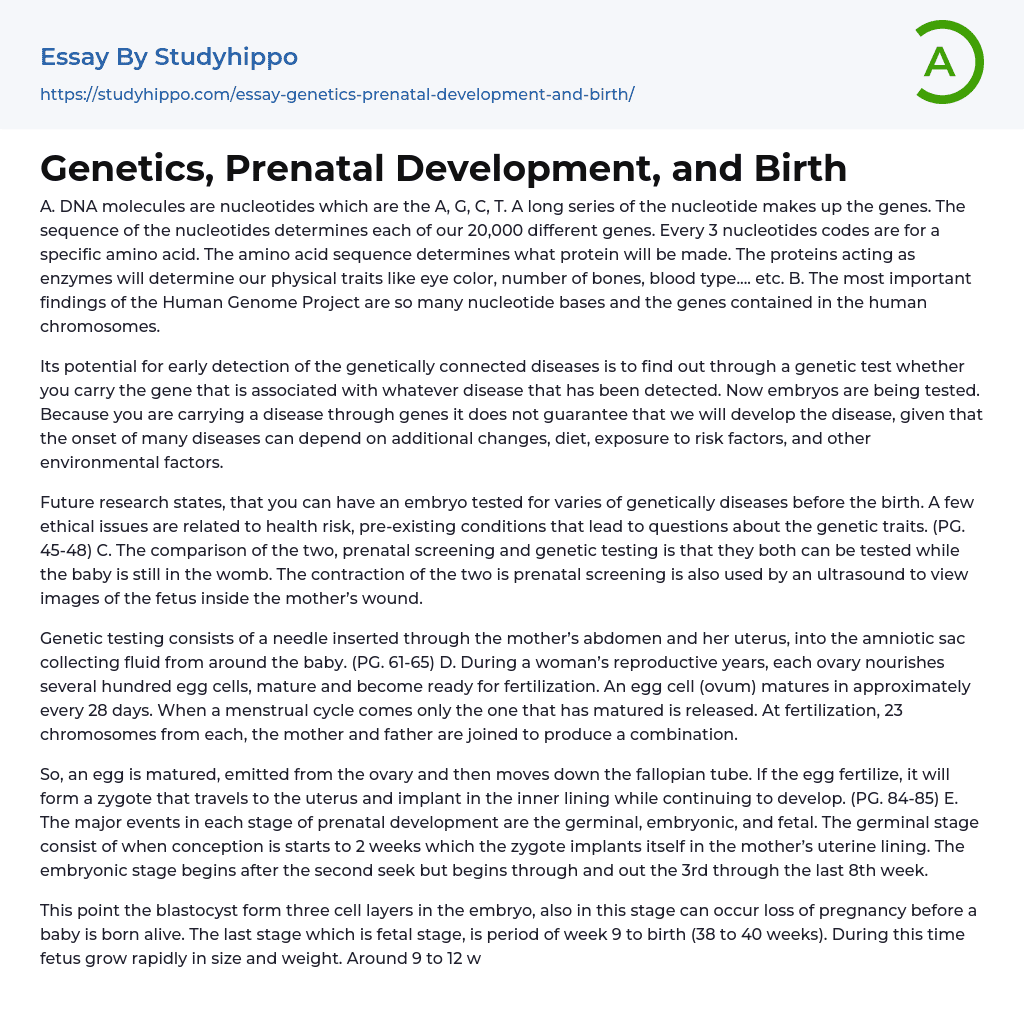A. DNA molecules are nucleotides which are the A, G, C, T. A long series of the nucleotide makes up the genes. The sequence of the nucleotides determines each of our 20,000 different genes. Every 3 nucleotides codes are for a specific amino acid. The amino acid sequence determines what protein will be made. The proteins acting as enzymes will determine our physical traits like eye color, number of bones, blood type.... etc. B. The most important findings of the Human Genome Project are so many nucleotide bases and the genes contained in the human chromosomes.
Its potential for early detection of the genetically connected diseases is to find out through a genetic test whether you carry the gene that is associated with whatever disease that has been detected. Now embryos are being tested. Because you are carrying a disease
...through genes it does not guarantee that we will develop the disease, given that the onset of many diseases can depend on additional changes, diet, exposure to risk factors, and other environmental factors.
Future research states, that you can have an embryo tested for varies of genetically diseases before the birth. A few ethical issues are related to health risk, pre-existing conditions that lead to questions about the genetic traits. (PG. 45-48) C. The comparison of the two, prenatal screening and genetic testing is that they both can be tested while the baby is still in the womb. The contraction of the two is prenatal screening is also used by an ultrasound to view images of the fetus inside the mother’s wound.
Genetic testing consists of a needle inserted through the mother’s abdomen and her uterus, into th
amniotic sac collecting fluid from around the baby. (PG. 61-65) D. During a woman’s reproductive years, each ovary nourishes several hundred egg cells, mature and become ready for fertilization. An egg cell (ovum) matures in approximately every 28 days. When a menstrual cycle comes only the one that has matured is released. At fertilization, 23 chromosomes from each, the mother and father are joined to produce a combination.
So, an egg is matured, emitted from the ovary and then moves down the fallopian tube. If the egg fertilize, it will form a zygote that travels to the uterus and implant in the inner lining while continuing to develop. (PG. 84-85) E. The major events in each stage of prenatal development are the germinal, embryonic, and fetal. The germinal stage consist of when conception is starts to 2 weeks which the zygote implants itself in the mother’s uterine lining. The embryonic stage begins after the second seek but begins through and out the 3rd through the last 8th week.
This point the blastocyst form three cell layers in the embryo, also in this stage can occur loss of pregnancy before a baby is born alive. The last stage which is fetal stage, is period of week 9 to birth (38 to 40 weeks). During this time fetus grow rapidly in size and weight. Around 9 to 12 weeks, the baby arm movements begin, first reflexes and the sex organs develop enough for examination of the fetus. By 17 to 20 weeks mother begin to feel movements. (PG. 85-89) F. Teratogen is which may cause birth defects.
The use of any drugs, tobacco substance get in the mother’s bloodstream and
crosses the placenta then damage the developing fetus by polluting in the mother’s tissue causing harmful chemicals being transmitted to the fetus. Infectious virus and sexually transmitted disease can also reach the fetus that’s in the mother. (PG. 90) G. The three stages of birth are dilation, delivery, afterbirth. One complication during birth involves the position of the fetus. The optimal fetal position is head down, that allows the head to move down the canal first and minimize risk to mother and baby.
But the baby may be in a breech position, buttocks or the feet are the lowest in the uterus which is malpresentation. Most malpresentation pregnancy will occur to have a cesarean section (C-section) delivery. Another one is fetal distress, the fetus experience lack of oxygen, change in heart rate, or change in respiration. A fetus can withstand brief oxygen deprivation with no ill effects, and when it’s oxygen decrease for more of a few minutes can lead to permanent brain damage. (PG. 101-103)
- Microbiology essays
- Bacteria essays
- Cell essays
- Enzyme essays
- Photosynthesis essays
- Plant essays
- Natural Selection essays
- Protein essays
- Viruses essays
- Cell Membrane essays
- Human essays
- Stem Cell essays
- Breeding essays
- Biotechnology essays
- Cystic Fibrosis essays
- Tree essays
- Seed essays
- Coronavirus essays
- Zika Virus essays
- Agriculture essays
- Albert einstein essays
- Animals essays
- Archaeology essays
- Bear essays
- Biology essays
- Birds essays
- Butterfly essays
- Cat essays
- Charles Darwin essays
- Chemistry essays
- Dinosaur essays
- Discovery essays
- Dolphin essays
- Elephant essays
- Eli Whitney essays
- Environmental Science essays
- Evolution essays
- Fish essays
- Genetics essays
- Horse essays
- Human Evolution essays
- Isaac Newton essays
- Journal essays
- Linguistics essays
- Lion essays
- Logic essays
- Mars essays
- Methodology essays
- Mineralogy essays
- Monkey essays




